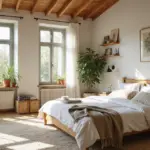As a Tropical Contemporary Specialist, I often find myself drawing inspiration from the lush landscapes of Latin America, seamlessly blending them with the structured elegance I admire in British gardens. What if I told you the secret to achieving this harmonious balance, right in your own backyard, lies in the often-underestimated power of shrubs? Forget fleeting annuals and temperamental perennials for a moment. Shrubs are the backbone of enduring, impactful design. They bring structure, texture, and year-round interest, acting as nature’s own architectural elements in your landscape. Ready to explore how to truly transform your outdoor space? Let’s delve into 21 shrub landscaping ideas that will redefine your yard, creating a sanctuary that’s both sophisticated and vibrantly alive.
1. Craft a Welcoming Entrance with Foundation Shrub Plantings
The entrance to your home? It’s your handshake with the world. Foundation plantings, those carefully chosen shrubs nestled against your house, are your opportunity to extend a warm invitation. But what are the best shrub types to plant near a home’s foundation for visual appeal and, crucially, structural safety? Think about it: we’re not just decorating; we’re integrating nature with architecture. For homes with clean, modern lines, consider the disciplined form of Japanese hollies or the architectural silhouette of dwarf conifers. Embrace the idea that foundation shrubs enhance the curb appeal and perceived value of a property – it’s the frame to your masterpiece.

Consider the mature size – no one wants overgrown shrubs swallowing their entryway. Think balance and proportion. A compact boxwood might lend a touch of British formality, while a carefully selected hydrangea, perhaps a lacecap variety, could introduce a softer, more romantic touch, echoing a tropical abundance, yet contained and refined. To really nail this, measure the foundation planting area and select shrubs appropriate for the space, considering sun exposure and soil type. Remember, preparation is key – amend the soil with compost and ensure excellent drainage. This is your canvas; prime it well.
Imagine guests arriving, greeted by a verdant, beautifully framed entrance. Now, let’s move beyond the threshold and consider how shrubs can define the garden spaces themselves.
2. Define Garden Beds with Low-Growing Shrub Borders
Think of garden beds as rooms in your outdoor home. And what does every good room need? Definition. Low-growing shrub borders are your stylish, natural walls. They elegantly delineate planting areas, creating order and visual appeal. But which low-growing shrubs are truly attractive and effective at defining garden bed edges? For a touch of Mediterranean chic, consider lavender – its silvery foliage and fragrant purple blooms are simply divine. Dwarf boxwood offers that crisp, evergreen structure I often incorporate in my designs, while the varied textures of heaths and heathers bring year-round interest and a touch of the wild, tamed.

Using shrub borders enhances the structure and visual organization of a garden, guiding the eye and preventing that unruly sprawl. Historically, knot gardens utilized low-growing shrubs like boxwood to create intricate geometric patterns – a testament to their defining power. And practically speaking, shrub borders help retain mulch and soil within garden beds, minimizing maintenance. To achieve this polished look, plant shrubs close together to create a continuous border, spacing them according to their mature width for a dense edge. Choose varieties that complement the style and colors of the plants within your beds, creating a harmonious whole.
With our garden rooms defined, let’s consider how to create private sanctuaries within them, using the natural artistry of shrubs.
3. Create a Natural Privacy Screen Using Tall Evergreen Shrubs
Privacy – a luxury we all crave. In landscape design, tall evergreen shrubs are your most elegant solution for creating secluded outdoor havens. Forget harsh fences; embrace living walls of greenery. But which tall evergreens are truly best suited for crafting a dense and effective privacy screen? Arborvitae, with their upright, columnar habit, are a classic choice for rapid screening. Leyland cypress grows even faster – a touch too vigorous for some, perhaps, but undeniably effective. For a more refined texture, consider the stately Japanese holly.

Evergreen shrub screens provide year-round privacy, and let’s not forget their functional beauty – acting as windbreaks and even noise barriers. Using natural shrub screens is an environmentally friendly alternative to stark walls, fostering biodiversity and contributing to cleaner air. Strategically planting evergreen shrubs to maximize privacy in a yard is all about density and layering. Select those evergreen shrubs that will reach your desired height for seclusion, suited perfectly to your local climate and soil. Then, plant them in a staggered row, or even a double row, allowing space to mature into a solid, verdant wall.
Now, privacy is essential, but what about inviting life into your garden? Let’s explore how shrubs can play a crucial role in attracting beneficial wildlife.
4. Attract Wildlife with Native Shrub Varieties
A garden should be a vibrant ecosystem, buzzing with life. Native shrub varieties are your secret weapon for attracting birds, butterflies, and vital pollinators, transforming your yard into a haven for local wildlife. What native shrub varieties are most effective at attracting beneficial wildlife, like our feathered and winged friends? Elderberry, laden with juicy berries, becomes a bird buffet, particularly during migration. Butterfly bush (though, in my designs, I always prioritize native alternatives like New Jersey Tea if Buddleia is invasive locally) lives up to its name, a nectar-rich magnet for butterflies.

Incorporating native shrubs contributes to local ecosystem health and biodiversity – it’s not just aesthetics; it’s responsible gardening. Native shrubs are exquisitely adapted to your local climate, requiring less pampering once established. And think of the fun facts! Native shrubs are adapted to local climates and require less maintenance once established, compared to non-native species. Many native shrubs produce berries and seeds that are crucial food sources for birds and other wildlife, especially during migration and winter. To create your wildlife haven, research local native shrubs that are beneficial to wildlife and suited to your yard’s conditions. Then, plant a diverse array of native shrubs that offer varied food sources and shelter.
Wildlife is wonderful, but let’s be honest, low-maintenance beauty is a modern desire. Let’s delve into the world of drought-tolerant shrubs.
5. Design a Low-Maintenance Landscape with Drought-Tolerant Shrubs
Life is busy, and gardens should soothe, not stress. Drought-tolerant shrubs are your allies in creating a visually stunning, yet remarkably low-maintenance landscape. Which drought-tolerant shrubs are best for a visually appealing, low-upkeep garden? Lavender, again, makes a stellar appearance, offering beauty and resilience. Rosemary’s aromatic foliage is both functional and water-wise. Sage, with its silvery foliage, thrives in sun and dryness, and certain Ceanothus varieties burst into vibrant blue blooms, demanding little water once established.

Designing a low-maintenance landscape with drought-tolerant shrubs is about smart plant choices. Consider xeriscaping principles – a water-wise approach where shrubs are central players. And fun fact: Drought-tolerant shrubs often have silvery or gray foliage which reflects sunlight and reduces water loss – nature’s own sunblock! Many are fragrant too, adding sensory delight. To create your low-water paradise, choose drought-tolerant shrubs that are perfectly suited to your climate and soil, grouping them based on shared water needs. Amend your soil for excellent drainage and mulch generously to conserve moisture.
Low-maintenance is fantastic, but let’s not compromise on year-round visual interest. Let’s explore how to orchestrate continuous color.
6. Add Year-Round Color with Evergreen and Flowering Shrub Combinations
A truly sophisticated landscape dances through the seasons, offering visual delights throughout the year. The secret? Combining evergreen shrubs for constant structure with flowering shrubs for seasonal bursts of color. How can you expertly combine evergreen and flowering shrubs for continuous year-round vibrancy? Evergreen boxwood offers that essential structural backbone, while hydrangeas erupt in summer blooms, many drying beautifully for autumnal interest. Rhododendrons, paired with the delicate blossoms of azaleas and the grounding texture of evergreen ferns, create a tapestry of seasonal shifts.

Think of evergreen shrubs as the stage – a constant, verdant backdrop that amplifies the drama of flowering shrubs. Fun fact: Evergreen shrubs provide a consistent green backdrop that enhances the vibrancy of flowering shrubs. Careful selection ensures almost continuous flowering from spring to fall. To create this dynamic display, select evergreen shrubs that provide a strong structural base and beautifully complement the colors of your chosen flowering shrubs. Then, strategically plant those flowering shrubs to create pops of color against the evergreen framework in different seasons.
Color is captivating, but depth and dimension elevate a garden from pretty to profound. Let’s explore the art of layering with shrubs.
7. Use Shrubs to Create Layers and Depth in Your Garden
Flat gardens lack intrigue. To truly captivate, we need layers – depth, dimension, a sense of journey. Shrubs are the masters of creating layered planting schemes, transforming a two-dimensional space into a rich, immersive experience. But how can shrubs effectively create these layered schemes, adding depth and visual interest? The principle is elegant: taller shrubs at the back, medium heights in the middle, low growers at the front. Think of it like composing a visual symphony. Within these layers, texture is key – combine shrubs with fine, medium, and coarse foliage; play with colors – greens, silvers, reds – to deepen the visual complexity.

Layered planting isn’t just aesthetically pleasing; it’s ecologically smart. Fun fact: Layered planting mimics natural plant communities, often resulting in healthier and more resilient gardens. It also enhances the perceived size of your garden. Creating layers can make a small garden appear larger and more spacious, drawing the eye through different levels. To achieve this depth, plan your garden design meticulously, placing taller shrubs at the back, graduating downwards to the front. Within each layer, combine shrubs with diverse textures and colors for maximum visual impact.
Layering creates depth in the garden bed, but what about bringing that dimension to our patios and decks? Containerized shrubs offer the perfect solution.
8. Frame Patios and Decks with Containerized Shrub Arrangements
Patios and decks, often hardscape havens, can feel somewhat… bare. Containerized shrubs are the alchemists that transform these spaces, adding life, structure, and a touch of portable paradise. What types of shrubs thrive in containers, perfectly framing patios and decks? Dwarf citrus trees bring a touch of the tropics, their fragrant blossoms and fruits a sensory delight. Boxwood balls, clipped and elegant, offer a formal counterpoint. Hydrangea paniculata ‘Little Lime’ blooms beautifully in pots, manageable and chic.

The beauty of containerized shrubs lies in their flexibility. Fun fact: Containerized shrubs offer flexibility to move plants around to optimize sunlight or protect them from harsh weather. They’re ideal for patios or decks with limited garden space. Using shrubs in containers is a great way to add greenery and structure to patios or decks, especially in areas with limited garden space. To master this look, choose shrubs specifically suited to container growing, always considering their mature size and sunlight needs. Select decorative pots with excellent drainage, and use a premium potting mix to nurture their growth.
Containers bring a touch of formality, and for truly structured elegance, nothing beats the sculpted hedge. Let’s explore the art of boxwood hedging.
9. Sculpt Hedges for Formal Garden Structure with Boxwood Shrubs
For gardens that exude timeless elegance and impeccable order, formal hedges are indispensable. And when it comes to formal hedging, boxwood shrubs reign supreme. Why are boxwood shrubs particularly well-suited for creating those impeccably formal hedges and topiary? Boxwood is prized for its dense, evergreen foliage and its remarkable tolerance for rigorous pruning. It’s the sculptor’s clay of the plant world. You can shape it into crisp, geometric hedges, elegant spheres, even whimsical spirals – the possibilities are limited only by your imagination (and perhaps your pruning shears!).

Boxwood hedges aren’t just a trend; they’re a legacy. Fun fact: Boxwood hedges have been a classic feature of formal gardens for centuries, dating back to ancient Roman gardens. How can sculpted boxwood hedges define garden spaces, creating that essential sense of formality and order? They act as living walls, delineating garden rooms, structuring pathways, and providing a sophisticated backdrop. To achieve this polished look, choose a boxwood variety specifically bred for hedging and topiary work, considering its growth rate and leaf size. Prune regularly – typically two to three times a year – with sharp shears, maintaining clean lines and your desired shapes.
Formal hedges offer structure, but sometimes, we need softness. Let’s explore how mounding shrubs can ease the harsh lines of hardscape.
10. Soften Hardscape Edges with Mounding Shrub Varieties
Hardscape – stone paths, patios, walls – provides essential structure, but its inherent rigidity can feel… well, hard. Mounding shrubs are the gentle antidote, offering rounded forms and soft textures to temper those sharp lines, creating a more natural, inviting landscape. Which mounding shrub varieties are most effective for softening hardscape, like walls or pathways? Dwarf Alberta spruce, with its neat, cone-like mound, is a classic choice. Certain rhododendrons offer rounded forms and exquisite blooms. Spirea japonica ‘Little Princess’ is a compact charmer with delicate pink blossoms and a gently mounding habit.

Mounding shrubs act as visual bridges, softening the transition from vertical hardscape to horizontal garden beds. Fun fact: Mounding shrubs can visually bridge the gap between vertical hardscape elements and horizontal ground planes. Softening hardscape edges with plants makes outdoor spaces feel more inviting. To achieve this softening effect, select mounding shrubs that beautifully complement the style and color palette of your hardscape materials. Plant them along the edges of walls, paths, and patios, allowing them to gracefully spill over the hard surfaces, blurring the lines between built and natural.
Softness is key, and so is sensory delight. Let’s awaken the sense of smell with fragrant shrubs near walkways and windows.
11. Plant Fragrant Shrubs Near Windows and Walkways for Sensory Delight
A truly immersive garden engages all the senses, and fragrance is a powerful, often overlooked, element. Planting fragrant shrubs near windows and walkways transforms your garden into a sensory-rich experience, a delight for both residents and visitors. But what are the best fragrant shrub varieties to plant near windows and walkways, maximizing that sensory enjoyment? Lilac, with its classic spring perfume, is a nostalgic and beloved choice. Daphne, especially in early spring, offers an intensely sweet, almost intoxicating scent. Gardenia, in warmer climates, exudes a heady, creamy fragrance. And Summersweet, true to its name, provides a delicate, sweet scent in the heart of summer.

Fragrant shrubs do more than just smell divine; they offer aromatherapy benefits, enhancing mood and well-being. Fun fact: Fragrant shrubs can enhance mood and well-being through aromatherapy benefits. Historically, fragrant gardens were designed to be therapeutic. To create your own fragrant haven, choose fragrant shrubs with scents you adore, suited to the sunlight and soil conditions near your windows and paths. Plant them strategically – close enough to windows to waft indoors on a breeze, along walkways to release their perfume as you stroll.
Fragrance delights, and so does seasonal transformation. As we move into autumn and winter, let’s explore shrubs that offer beauty beyond the typical bloom season, with vibrant berries.
12. Choose Shrubs with Berries to Enhance Autumn and Winter Interest
As summer’s floral fireworks fade, many gardens lose their vibrancy. But autumn and winter need not be drab. Shrubs with berries step into the spotlight, injecting much-needed color and visual interest into the cooler months. Which shrubs produce the most colorful and long-lasting berries, providing that essential autumn and winter appeal? Winterberry holly is legendary for its brilliant red berries that persist through snow and frost. Beautyberry bursts forth with vibrant purple berries in fall. Viburnums and cotoneasters offer a spectrum of berry hues and extended displays.

Berry-producing shrubs offer more than just visual appeal; they are vital food sources for birds during winter. Fun fact: Berry-producing shrubs often have berries that persist through winter, providing prolonged seasonal interest. Some berries even change color as they mature, adding dynamic interest. To create your winter berry display, select berry-producing shrubs with berry colors and ripening times that complement your autumnal and winter garden palette. For hollies, remember to ensure proper pollination by planting both male and female plants if necessary.
Berries offer color, but for textural richness in winter, let’s consider the often-underappreciated beauty of shrub bark.
13. Incorporate Shrubs with Interesting Bark for Textural Landscapes
When leaves fall, the garden’s structure is revealed, and bark becomes a star player. Shrubs with interesting bark textures and colors add a layer of visual richness, especially crucial in the winter landscape when other elements fade. Which shrubs are truly known for their distinctive and visually appealing bark, adding textural interest? Red twig dogwood – a winter icon – flashes vibrant red bark against the snow. Paperbark maple (smaller cultivars are garden-appropriate) displays peeling, cinnamon-colored bark that’s simply exquisite. Coral bark maple (again, smaller cultivars) offers striking coral-red stems. Oakleaf hydrangea develops intriguing peeling bark with age.

Fun fact: The bark of some shrubs becomes more colorful and pronounced in winter after leaves have fallen. Bark texture and color provide visual interest even when shrubs are dormant. To showcase bark beauty, select shrubs with bark that offers a strong contrast to your other garden plants. Plant them where they can be readily admired, particularly in winter – near pathways, windows, or viewed from indoors.
Texture in winter is wonderful, but for pure romantic charm, let’s turn our attention to cottage gardens brimming with flowering shrubs.
14. Design a Cottage Garden Filled with Romantic Flowering Shrubs
Cottage gardens – they’re the embodiment of romantic abundance, informal charm, and overflowing beauty. And at their heart? Flowering shrubs, providing structure and that essential cottage garden exuberance. Which flowering shrubs are truly essential for creating the romantic atmosphere of a cottage garden? Shrub roses, with their classic blooms and often intoxicating fragrance, are quintessential. Hydrangeas, especially mophead and lacecap varieties, offer those billowy, romantic blooms. Lilacs, with their nostalgic spring fragrance and abundant flowers, are another cornerstone. Weigela and mock orange add a touch of wilder romance, cascading blooms that spill and soften.

Cottage gardens aren’t just pretty; they have a history. Fun fact: Cottage gardens originated as practical kitchen gardens, evolving into a romantic and informal garden style. Their relaxed planting style encourages biodiversity and attracts pollinators – beauty and function. To design your own cottage dream, choose a mix of flowering shrubs with varied bloom times and flower forms, favoring soft, romantic hues – pinks, purples, whites, blues. Plant them in informal groupings, intermingling with perennials and annuals to create that signature cottage garden fullness, a touch intentionally ‘overgrown’ yet utterly charming.
Cottage gardens are delightful, but shrubs offer practical solutions too. Let’s consider their role in erosion control, particularly on sloped terrain.
15. Utilize Shrubs for Erosion Control on Sloped Areas
Slopes – they can be visually dynamic, but also challenging, prone to soil erosion and runoff. Shrubs, with their deep, anchoring root systems, are nature’s engineers for slope stabilization. Which shrubs are best suited for erosion control on slopes, effectively holding soil in place? Creeping juniper, with its low, spreading growth, acts as a living groundcover, clinging to slopes. Dwarf fothergilla, with its dense foliage and strong roots, is another excellent choice. Certain cotoneasters, with their spreading habit and soil-binding roots, are also slope-stabilizing heroes.

Shrubs are more effective than grass alone for slope erosion control, thanks to their deeper, more robust root systems. Fun fact: Shrubs are more effective than grass alone in preventing soil erosion on slopes due to their deeper root systems. Planting shrubs for erosion control reduces water runoff and improves water quality. To effectively use shrubs for erosion control, select varieties with extensive root systems and low, spreading growth, perfectly matched to your slope’s conditions. Plant them densely, perhaps utilizing terracing or contour planting techniques to maximize soil stability.
Erosion control is practical, and sometimes we need a focal point, a star of the show. Let’s explore specimen shrubs.
16. Create a Focal Point with a Specimen Shrub in a Key Garden Area
Every garden needs a ‘wow’ moment, a focal point that draws the eye and anchors the design. Specimen shrubs, with their unique forms and striking features, are your go-to for creating these captivating centerpieces. Which shrubs make the most striking specimen plants, effectively serving as focal points? Japanese maples (choose shrub-form varieties) are unrivaled for their foliage color and graceful structure. Blue Star Juniper offers a unique, silvery-blue hue and textural intrigue. Oakleaf hydrangea boasts those distinctive oak-shaped leaves and showy blooms. Bottlebrush buckeye delivers unusual, summer bottlebrush-like flowers.

A well-chosen specimen shrub becomes a year-round garden highlight, offering seasonal shifts in foliage, bloom, and bark. Fun fact: A well-chosen specimen shrub can become a year-round highlight in the garden, providing seasonal interest. Specimen shrubs are often architectural wonders, selected for unique forms and colors. To craft a compelling focal point, choose a specimen shrub that offers strong contrast with its surrounding plants in form, color, or texture. Place it strategically – at a garden entrance, the center of a bed, or at the terminus of a sightline, ensuring it commands attention.
Specimen shrubs command attention, but for a truly dynamic garden, consider the interplay of shrubs and perennials in mixed plantings.
17. Mix Shrubs with Perennials for Dynamic Plant Communities
Monoculture plantings? Predictable. Mixing shrubs and perennials, however, creates vibrant, ever-evolving plant communities, mimicking the dynamism of nature itself. How can shrubs and perennials be effectively combined, creating dynamic, long-lasting plant communities? The key is harmony and contrast – pair shrubs and perennials based on complementary colors, textures, and bloom times. Evergreen shrubs provide a consistent backdrop for seasonal perennial displays.

Mixing shrubs and perennials creates plant communities that mimic natural ecosystems, often leading to greater resilience and ecological richness. Fun fact: Mixing shrubs and perennials creates plant communities that mimic natural ecosystems, often leading to greater resilience. This combination extends bloom times and visual interest throughout the year. To achieve successful mixed plantings, select shrubs and perennials with shared growing needs – sun, soil, water. Arrange shrubs as structural anchors, filling in around them with perennials, carefully considering bloom seasons and foliage textures for year-round appeal.
Mixed plantings are dynamic, and for a garden that invites exploration, let’s consider using shrubs to guide pathways and garden flow.
18. Use Shrubs to Guide Pathways and Garden Flow
Pathways aren’t just functional routes; they’re opportunities to create a journey, a narrative through your landscape. Shrubs, planted strategically along paths, define routes, create a sense of enclosure, and subtly direct movement through your garden spaces. How can shrubs be strategically planted along pathways, enhancing both movement and the garden experience? Low to medium-height shrubs are ideal for defining path edges without feeling restrictive. Dwarf lavender, boxwood, and dwarf fothergilla are excellent pathway companions. Introduce curves and turns to your pathways, using shrubs to create these gentle detours, leading visitors through different ‘rooms’ of your garden.

Shrubs lining pathways create anticipation, hinting at what awaits around the bend. Fun fact: Shrubs lining pathways can create a sense of anticipation and discovery as visitors move through the garden. Pathway plantings also soften hard edges, blending path and garden seamlessly. To master this, choose shrubs that won’t overwhelm the path or obstruct movement, considering their mature size and pruning needs. Plant them along path edges with consistent spacing for a sense of order and flow.
Pathways guide, and for those tricky shady spots under trees, let’s uncover the beauty of shade-tolerant shrubs.
19. Select Shade-Tolerant Shrubs for Under Tree Plantings
Shady areas beneath mature trees? Often a gardener’s dilemma. But shade doesn’t have to mean barren. Shade-tolerant shrubs are the solution, thriving in dappled light and transforming those tricky spots into lush, green understories. Which shade-tolerant shrubs thrive under trees, adding beauty to these often-neglected areas? Rhododendrons and azaleas are classic shade lovers, bursting into bloom even under canopies. Fothergilla, with its fragrant flowers and fall color, is another excellent choice, as is oakleaf hydrangea, known for its large leaves and shade tolerance.

Shade-tolerant shrubs thrive where grass often struggles, making them invaluable for utilizing shaded spaces. Fun fact: Shade-tolerant shrubs can thrive in areas where grass may struggle to grow due to shade and root competition. Planting shrubs under trees creates a natural woodland understory, enhancing the ecosystem. To succeed with under-tree plantings, choose shade-tolerant shrubs that are also tolerant of root competition from trees. Amend the soil with compost and mulch generously to improve moisture retention and nutrient availability.
Shady areas transformed, let’s move to the front yard and consider how shrubs can boost curb appeal.
20. Enhance Curb Appeal with Neatly Trimmed Front Yard Shrubs
Curb appeal – it’s the visual handshake your home extends to the neighborhood. Neatly trimmed front yard shrubs are fundamental to creating a polished, welcoming presentation, instantly boosting your home’s charm. How do neatly trimmed shrubs contribute to enhancing curb appeal and the overall front yard appearance? They signal care and attention, creating a positive first impression and significantly increasing property value. Symmetrical designs, featuring crisply trimmed boxwood hedges and perhaps a topiary accent, project classic sophistication.

Well-maintained front yard shrubs create a positive first impression and increase property value – it’s an investment in your home’s image. Fun fact: Well-maintained front yard shrubs create a positive first impression and increase property value. Neatly trimmed shrubs create order and sophistication in front yard landscaping. To maximize curb appeal, select shrubs that naturally maintain a compact form or respond beautifully to pruning – boxwood, Japanese holly, dwarf yews are all excellent choices. Prune regularly, using hand shears for precise shaping, maintaining those clean, crisp lines.
Curb appeal enhanced, let’s finally consider how to enjoy blooms for the longest possible season, with successive flowering shrubs.
21. Extend the Blooming Season with Successive Flowering Shrub Varieties
Why settle for a fleeting bloom season when you can orchestrate a continuous floral display? Selecting successive flowering shrub varieties is the key to extending your garden’s beauty from early spring through late fall. How can you skillfully select and combine flowering shrubs, crafting a garden with a prolonged bloom season? Think of it as a floral relay race. Forsythia kicks off spring with a burst of yellow, followed by azaleas in their pastel glory. Hydrangeas take center stage in summer, and rose of Sharon brings late-summer, early fall color. Witch hazel, incredibly, even flowers in late fall and winter, pushing the season’s boundaries. Layering bloom times, using shrubs that flower in sequence, is the art of continuous color.

By choosing shrubs with staggered bloom times, you can enjoy flowers in your garden for a vastly extended period. Fun fact: By selecting shrubs with staggered bloom times, you can enjoy flowers in your garden for a much longer period. Successive blooming shrubs also provide a continuous food source for pollinators. To create your extended bloom tapestry, research the bloom times of diverse flowering shrubs, selecting varieties that offer a sequence of color from early spring to late fall. Plant these shrubs in proximity, ensuring a continuous, evolving floral display throughout the growing season.
Conclusion
From the structured elegance of foundation plantings to the romantic abundance of cottage gardens, from privacy screens to pollinator havens, these 21 shrub landscaping ideas reveal the transformative power of these versatile plants. They are, in essence, the architects of our gardens, providing structure, seasonal dynamism, and year-round beauty. Embracing shrub landscaping ideas allows us to move beyond fleeting trends and create outdoor spaces that are both enduring and deeply enriching. So, take these ideas as a starting point, explore the vast palette of shrubs suited to your climate and style, and prepare to witness your yard blossom into a landscape that is not just visually stunning, but a true reflection of your own personal sanctuary. Start small, perhaps with enhancing your entrance, or defining a garden bed – and watch as the magic of shrub landscaping ideas unfolds, transforming your yard, one thoughtfully chosen shrub at a time.






